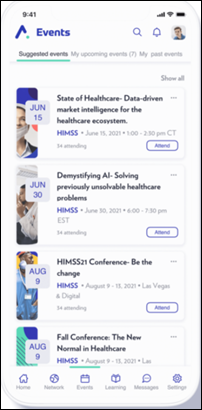News 7/30/21
Top News

HIMSS will require HIMSS21 attendees and exhibitors to wear masks on the conference campus. This decision follows publication of new CDC guidelines and state and local emergency orders.
HIMSS says that 18,000 people have registered for the in-person and virtual versions of HIMSS21. HIMSS19 had 43,000 registrants.

Clark County’s test positivity rate is at 15.5%. County hospitalizations are at 1,000 versus early January’s all-time high of around 1,400.

Medicomp cancelled its HIMSS21 participation Thursday afternoon, the first company that has told me directly that deteriorating COVID conditions convinced them to stay home.
Reader Comments
From Oliver Twist: “Re: HIMSS21. It’s time to do the right thing and cancel. As much as I want it to happen, it would be the wrong decision, and the only reason to proceed is financial. If public health is not a HIMSS priority, what is? Just don’t wait until next week and add to the hardship.” I’m waiting until the weekend to see if HIMSS cancels the event (a couple of companies have told me they’re doing the same). If they don’t cancel, I’m probably 60% likely to attend, down from 100% a few days ago, but that number is declining as I weigh the ever-worsening risk versus reward as evidenced by new studies regarding Delta variant breakthrough infections, the possibility of tapering vaccine protection, and the potential of developing long COVID from a mild breakthrough infection. Plus HIMSS22 is just 227 days away and should be the first non-asterisked HIMSS conference since 2019. I have $895 invested in rolled-over HIMSS20 registration fees, a few hundred dollars in a flight that probably isn’t refundable, and $1,000 for the OnPeak-booked hotel that appears to be refundable minus one night. I feel sorry for HIMSS, which weathered the financial hit and no-refund fallout of HIMSS20, only to see the pre-Christmas joy of cheering on the Pfizer trucks that were delivering the miracle of science dashed by the reality that a lot of people are indifferent or hostile to science.
From HIMSS Fail: “Re: HIMSS21. Disappointed that HIMSS isn’t offering the Nursing Informatics Symposium virtually. My registration fees for last year were transferred to this year, but as a healthcare professional, I don’t think it’s responsible given the rise in the Delta variant to travel to Las Vegas and be exposed to crowds of people. HIMSS has had a year to figure out how to host a virtual an in-person conference. So I’ve lost my registration fees and perhaps in the future HIMSS will lose my membership fees.”
From MyAlias: “Re: HIMSS21. Word is that vendors and health systems are pulling out. Are you hearing the same?” No, but companies wouldn’t necessarily tell me. Last year’s pullout was evidenced by diminishing numbers on the frequently updated HIMSS20 exhibitor list, which I haven’t seen with the HIMSS21 list. It could be that the exhibitor list isn’t being updated the same way, and regardless we wouldn’t easily know how many provider organizations have banned travel to Las Vegas. Let me know if your employer has cancelled your planned attendance.
From Calico: “Re: HIMSS21. Is the exhibitor count apples to apples with that of previous years? Half the usual number doesn’t seem like a bad turnout.” That includes a bunch of first-time exhibitors and 125 or so companies that booked a meeting room (either instead of or along with a regular booth). I see 410 occupied booths in Sands Expo of 200 square feet or larger, so that leaves maybe 285 good-sized booths that aren’t in MP. Jump to 400 square feet – still pretty modest – and you’re down to about 65 companies. I haven’t run the lists to see which of the usual suspects won’t be exhibiting.
From Rashaverak: “Re: Epic. Accused of paying health systems exorbitant amounts to use its ~20 often inaccurate predictive diagnosis models. Epic says it doesn’t do marketing, but it appears its practices are no different than any other software vendor.” Stat News says unidentified employees of several health systems told its reporters that Epic’s sepsis prediction model is unreliable, but Epic pays hospitals incentives for using them in its voluntary Epic Honor Roll programs.
HIStalk Announcements and Requests
Listening: the reader-recommended new album from Blue Oyster Cult. It sounds good, in a snarly biker kind of way, for band whose remaining original members are 76 (Eric Bloom) and 73 (Buck Dharma). The video includes some self-parody when BOC’s original drummer Albert Bouchard pops in to provide “more cowbell.” There’s also a Spinal Tap reference.
Webinars
On-Demand Webinars:
“Key Differences: Value Based Care vs. Fee-For-Service.” Part 1 of a three-part series. Sponsor: Net Health. Presenters: Bill Winkenwerder, MD, chairman, CitiusTech; Josh Pickus, CEO, Net Health. Dr. Bill Winkenwerder, former assistant secretary of defense for health affairs for the US Department of Defense, shares his unique perspective on the future of value-based care (VBC) systems in the public sector and how VBC differs from fee-for-service models in the private sector. This Part 1 webinar covers which aspects of the fee-for-service health system payment model look the most different compared to fully value-based systems (clinical, back-office, analytics, etc.)
“Current Innovation and Development in Value-Based Care.” Part 2 of a three-part series. Sponsor: Net Health. Presenters: Bill Winkenwerder, MD, chairman, CitiusTech; Josh Pickus, CEO, Net Health. Dr. Bill Winkenwerder, former assistant secretary of defense for health affairs for the US Department of Defense, shares his unique perspective on the future of value-based care (VBC) systems in the public sector and how VBC differs from fee-for-service models in the private sector. This Part 2 webinar discusses what health systems should know about the transition to value-based care, including macro versus micro shifts.
“Future of Value-Based Care: Predictive Analytics, Technology, Policy.” Part 3 of a three-part series. Sponsor: Net Health. Presenters: Bill Winkenwerder, MD, chairman, CitiusTech; Josh Pickus, CEO, Net Health. Dr. Bill Winkenwerder, former assistant secretary of defense for health affairs for the US Department of Defense, shares his unique perspective on the future of value-based care (VBC) systems in the public sector and how VBC differs from fee-for-service models in the private sector. This Part 3 webinar discusses the role analytics will play in the shift to value-based care and how financial and clinical ROIs for analytics-oriented products must differ when applied to FFS and VBC models.
Previous webinars are on our YouTube channel. Contact Lorre to present your own.
Acquisitions, Funding, Business, and Stock
Cerner will announce Q2 earnings Friday morning at 9:00 ET, which will be a much-followed event given its CEO search and takeover speculation. UPDATE: Cerner reports that revenue was up 10%, adjusted EPS $0.80 versus $0.63, beating analyst expectations for both.
Telehealth provider Amwell will acquire digital mental health platform vendor SilverCloud Health and text-based automated patient interaction developer Conversa Health for a combined $320 million.

Avera Health (SD) sells its telemedicine services company Avera ECare to a private investment firm that will take on its 230 employees and rename the company Avel Ecare. Services include behavioral health, correctional health, emergency, hospitalist, ICU, pharmacy, school health, specialty clinic, and senior care. Terms of the acquisition were not announced.
Clinical performance management technology vendor MDmetrix announces a $6 million Series A funding round and a name change to AdaptX. Co-founder and CEO Warren Ratliff, JD was co-founder and COO of Caradigm.
Private equity firm Hughes & Company closes its first fund at $116 million, which will make investments of $5-$20 million in lower middle market healthcare software and technology enabled companies. The firm has an active investment in Azara Healthcare and exited its stake in Aldera, Aperture, and IN2L.
Sales
- UMass Memorial Health chooses Halo Health for clinical communication and collaboration.
People

US Army Lieutenant Colonel Alison Murray, MS, MSN, RN is assigned to clinical informatics specialist and CMIO at Dwight D. Eisenhower Army Medical Center. She has also been named a recipient of the Order of Military Medical Merit.

MDClone promotes Erin Giegling to VP of marketing.

Scottsdale Institute promotes Janet Guptill, MPH to president and CEO.
Announcements and Implementations
Health Catalyst announces PowerLabor, an AI-enabled view of health system labor data that is part of its Financial Empowerment Suite.
Cerner will sell its Continuous Campus in Kansas City, KS as a predominantly hybrid work model reduces its real estate needs.
Dubai-based Etisalat Digital launches a cloud-based EHR to meet the UAE government’s requirement for a centralized, connected medical record for every citizen and resident.

The digital arm of India’s Apollo Hospitals Group will launch a Microsoft Teams-based solution that will offer virtual visits with Apollo physicians, prescription ordering, and scheduling lab sampling at home.

Well Health launches ChatAssist AI, a chatbot that it says completes 95% of patient-provider conversations without human intervention. Epic user Sansum Clinic’s six-month pilot focused on the chatbot’s use for telehealth, portal enrollment, insurance verification, and COVID-19 vaccination.

A new KLAS report on nurse and staff scheduling finds that the strongest products for using predictive analytics to manage staffing up to two months in the future are Symplr ShiftSelect and HealthStream ANSOS Staff Scheduling. Those products were acquired by their current vendors in February 2019 and November 2020, respectively. Cerner Clairvia delivers high customer satisfaction for same-day analytics.
Government and Politics
ONC opens the synchronized feedback period for the Interoperability Standards Advisory, the Standards Version Advancement Process, and the draft United States Core Data for Interoperability Version 3.
Sponsor Updates
- Meditech will host its virtual Expanse Summer Showcase August 10-11.
- First Databank VP of Clinical Content Joan Kapusnik-Uner co-authors the study, “Using Medicare Data to Assess the Proarrhythmic Risk of Non-Cardiac Treatment Drugs that Prolong the QT Interval in Older Adults: An Observational Cohort Study.”
- The Atlanta Healthcare Entrepreneur Meetup will feature Jvion Chief Marketing Officer Lizzy Feliciano August 5.
- Medicomp’s Tell Me Where It Hurts Podcast features Jessica Cox, RN from Holy Name Medical Center.
- Meditech publishes a new case study, “Emanate Health Advances COVID-19 Contact Tracing with Meditech Professional Services.”
Blog Posts
- Operational Resilience: Grow Your Business Despite Increasing Threats (Everbridge)
- EMR vs. EHR: Understanding Electronic Health and Medical Records (Experity)
- Is a Digital Rounding Solution Right for Your Organization? (GetWellNetwork)
- Cerner Recognized as a Leader in Diversity, Equity and Inclusion by Forbes, Kansas City Chamber (Cerner)
- Optimize Your Labor Management with Health Catalyst PowerLabor (Health Catalyst)
- 2022 PFS Proposed Rule Part 2: MIPS Value Pathways (MVPs) Proposals (Impact Advisors)
- Looking Back and Leaping Forward: How Unprecedented Times Shaped the Way of the Future for Health Seekers’ Online Experience (Loyal)
- Why A Patient Engagement Solution May Not Be the Best Choice for Patient Experience (Lumeon)
- Digital vaccination passports put a new twist-er on leaving your house (Lyniate)
- CMS Ups the Ante on Price Transparency Compliance (Medhost)
- 8 Powerful Team Building and Motivational Strategies for Physical Therapists (MWTherapy)
Contacts
Mr. H, Lorre, Jenn, Dr. Jayne.
Get HIStalk updates.
Send news or rumors.
Contact us.













































Anything related to defense will need to go to Genesis.